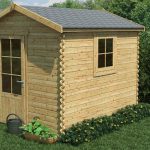Spending time in nature with your home on wheels, a.k.a. trailer, is one of life’s simple yet great pleasures. When the going gets tough on a day-to-day basis, it’s the perfect escape that can recharge our energies and help us get back in the rat race refreshed and with a new mindset. Still, for the trip outdoors to be fun and without any stress, you ought to keep everything in perfect condition. And by everything, I mean down to the last detail.
You can take good care of axles and air springs all you want, but if you fail to pay the jockey wheel the same amount of attention, you’re in trouble, to say the least. For such a simple, adjustable, and retractable mechanical device, it plays a rather important role – that of lifting and lowering the coupling head, making for easy manoeuvring of the front of the trailer to the towing vehicle or from it for storing while keeping it level and steady.

In short, it’s a height-adjustable wheel that helps with the hitching or unhitching of a trailer, as much as a caravan or even a boat. Since it can take a significant impact, it can undergo some damage or wear and tear if not handled or maintained properly. In this case, you’d have to look for suitable jockey wheels to make an adequate replacement. This is both for your safety and comfort throughout the holidays.
How Do I Choose a Jockey Wheel?
Keeping in mind this piece is available in a range of types, materials, diameters, and load capacities, you should be careful to avoid mistakes. To start, it’s advisable to measure up your existing wheel, specifically, its height from top to bottom, including the outer width of the vertical metal tube, otherwise known as a sleeve. Then, get to know the options:
Types of Jokey Wheels
Here you have the choice between the standard (i.e. fixed) jockey type and the swivel jockey wheels. The fixed type is welded to the trailer’s drawbar or bolted and doesn’t need removal when connecting the trailer. Whereas with the swivel type, you have adjustability with the release handle that allows you to set the wheels for travelling and adjusting the height.
Not having to remove the jockey means not needing a space to store it when it’s not in use. Okay, so knowing which of these two you have and require will simplify your quest for the perfect piece. There’s a third choice for enormous and weighty loads in the form of caravans, which is the heavy-duty ratchet type. When safely manoeuvring trailers with high drawbar weight, it’s best to use the help of jack stands as they can hold up to 5 tonnes of weight.

Types of Wheels
Here too, you can pick between two options: the solid and the pneumatic. The solid wheels are meant for use on solid surfaces such as concrete or soil and are typically made of sturdy nylon and rubber. The pneumatic, on the other hand, are air-filled and better left for use on softer terrain like the beach or muddy grounds. Because of the different diameters, swaps between the two aren’t that doable or possible.
Types of Sleeves
In the cases of replacements of entire jockey wheels, you have to consider the sleeves. And this boils down to:
- The smallest and lightweight 34mm sleeve;
- The slightly bigger 42mm sleeve for light trailers;
- The standard 48mm sleeve for boat trailers;
- The heavy-duty 60 -63mm sleeves.
Load Capacities
Same as all of the aforementioned aspects, you can’t overlook the weight of the jockey wheels they’re designed to handle to avoid mishaps. You’ve got the chance to shop from:
- Standard pneumatic wheels that can hold up to 160kg static load;
- Swingaway pneumatic wheels that can hold up to 160kg static load;
- Solid cushion wheels that can hold up to 750kg static load;
- Heavy-duty wheels that can hold up to 1250kg static load.
How Do I Know If My Jockey Wheels Are Worn Out?
Knowing when to replace your existing wheels can save you from unnecessary purchases as much as an accident, so it’s wise to keep an eye on them at all times to note any warning signs. First of all, any physical sign of damage or bent parts means they need to replace the jockey wheels that are in top condition. If you can’t elongate or retract them, this is yet another sign you ought to do some shopping.

Sometimes, it can be something as simple as dirt or rust that can prevent the wheels from working at their best as they’re intended to do, so be sure to also check for these two. Doing some occasional bearing greasing is recommended too to keep them well lubricated and operating smoothly, and some professional servicing (if you can’t do it yourself) every year or so to keep them in great shape and extend their lifespan.


